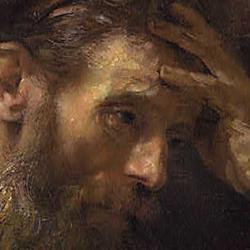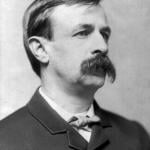Lawrence Wellborn gave a fascinating paper on Alain Badiou’s treatment of Paul. I’m not sure I can summarize everything in his rich and wide-ranging paper, but I’ll try to get some of the main themes in the enumerated points below.
1) He began with a summary of what Badiou means by a “truth event.” This is a “rupture” or “tear” in the social fabric that restructures the coordinates of desire, and is part of the progression of human beings from social animals to human subjects. The event creates a disorganization that might become itself the grounds for a new organization. (Wellborn didn’t say this, but I’m suspicious about this progression from “social animal” to “human subject.” Is that an evolutionary scheme? Is Badiou absolutizing the specific history of the Western self?)
2) An event can also be described in terms of Althusser’s notion of “interpellation.” Social organization and especially discourse interpellates the us in guilt, shame, and servitude. But every situation, every interpellation, is a structure around a void. This “situated” void is the unnamed nothing at the heart of a social order that structures the social order. What makes bourgeois society function are the “proletariat” workers who are treated as nobodies and have no social standing. These nothings form the void around which bourgeois society is organized. Badiou describes an event as the naming of a void – Marx’s work is an event because he gave the name “proletariat” to the void at the heart of capitalist social order.
3) Paul is crucial to Badiou because Paul names the void of late antiquity and blasts open that void. The void is the reality of death, the death-in-life that characterized mid first-century Greco-Roman culture. Some of the most interesting sections in Wellborn’s paper had to do with his discussion of Ovid, Seneca, Philo, and others, in all of whom he detects a sense of death-in-life, living death. He connected (somewhat tenuously) to the rise of the empire; Augustus destroyed the Roman character (so Tacitus) and left Romans stumbling around like zombies in an empty landscape. The educated members of Paul’s audience would have shared this ennui and despair with Seneca, gripped by fantasies of suicide. Paul comes on the scene, Badiou suggests, announcing the resurrection, the possibility that life can become the center of life’s gravity, replacing death. The gospel comes as a “vital rupture” in Greco-Roman culture, and the announcement that Jesus is risen and reigns shows that Augustus and death no longer hold sole sovereignty.
4) What of the lower classes in Paul’s audience? Here the void at the center of social life takes a particular shape, the shape of a cross. Drawing on his earlier studies on crucifixion in the Greco-Roman world, he argued that the cross was common, specifically designed to keep slaves and nobodies in their place, and yet completely unmentionable in polite society. For Cicero, crucifixion is too awful to talk about; it is nothing. Yet this nothing keeps the Roman world running by making sure that the slaves don’t get control. Then Paul comes along to name the void, and not only to name the void but to show that the reign of death is ended. The announcement that God’s Christ has identified Himself the nobodies and nothings convokes the nobodies and nothings to faith. Hence Paul links the claim that he preaches a crucified Messiah with the ecclesiastical claim that the new humanity is made up of the dregs of this world – not many wise, not many well born, not many wealthy.
5) Wellborn is critical of Badiou on the central question of the role of the cross. In an effort to avoid a Hegelian dialectical understanding of cross and resurrection, Badiou skims past the cross. The truly vital rupture is not the cross but the announcement of the resurrection. But Wellborn argued that the gospel of the cross itself would be heard as a vital disruption, opening up the possibility of life beyond the regime of death.
6) Wellborn ended by suggesting that Badiou’s Jesus does not really open a new possibility for human existence. Rather, his Jesus is much more like Nietzsche’s Ubermensch, his death not constitutive of the life He brings but rather a mere demonstration of His true human mortality. This, Wellborn said, is not the Pauline announcement. In a response, JL Louis Martyn wondered whether Badiou is among those who finds the cross foolishness. Wellborn demonstrated pretty well that he is.











